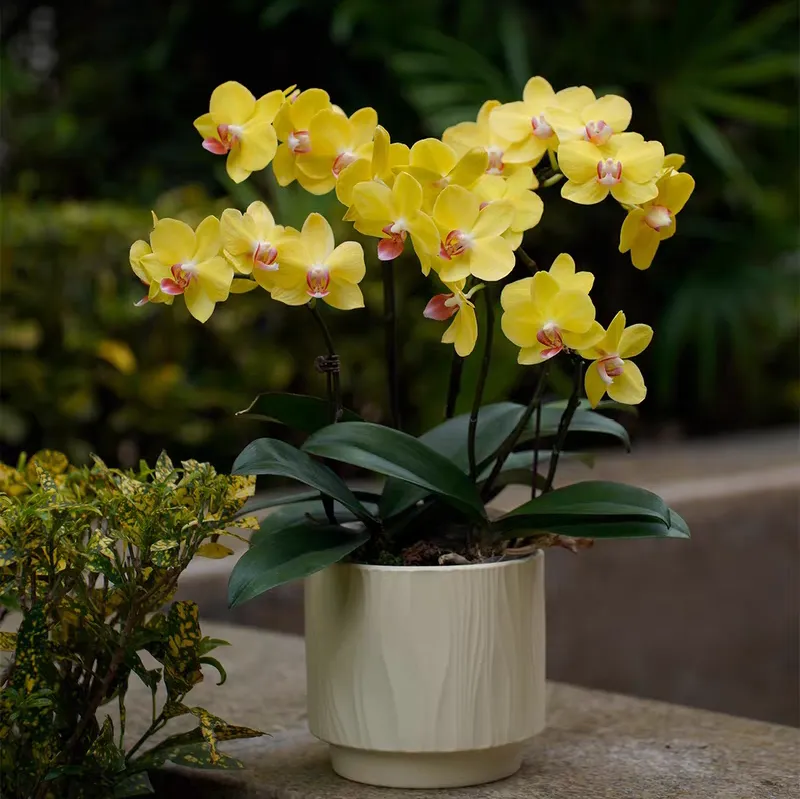During the plum rain season, although the rain provides natural moisture for the growth of Phalaenopsis, it also brings many potential risks. If proper maintenance measures are not taken in a timely manner, it is very likely to cause plant diseases and even death.
## Dehumidification
1. Remove accumulated water: Immediately after rainfall, use dry absorbent paper towels or professional air - blowing equipment to carefully clean the parts where water is likely to accumulate, such as the leaf core and the leaf neck, to avoid water residue. If it is impossible to handle each plant individually due to limited conditions, the flower pot can be tilted at a 45 - degree angle and slowly inverted and shaken to make the accumulated water drain out. It should be noted that although a small amount of rain attached to the leaf surface can supplement water, the water accumulated in the leaf core and roots must be removed in a timely manner.
2. Ventilation and drying: It is recommended to use an electric fan to assist ventilation. Ordinary plants that have been rained on need to be blown for more than 2 hours, and plants with obviously wet planting materials need to be blown for up to 6 hours. For large plants with developed root systems, continuous ventilation for 2 days may be necessary to ensure sufficient air circulation. When the natural wind is insufficient, artificial intervention is required to reduce the environmental humidity and effectively inhibit the growth of bacteria such as neck rot and soft rot. If the water content of the planting material is too high, the plant should be immediately removed from the pot and placed in the air to be blown until the planting material reaches a semi - dry state.
## Sterilization
Two to three days after the rain stops, when the water on the plant surface has completely evaporated, systematic sterilization protection is required. Select professional fungicides such as carbendazim and thiophanate - methyl, and after diluting them according to the proportion stated in the product instructions, spray the leaves and pour the solution onto the roots to double - block the spread of pathogenic bacteria. Especially in the environment where it turns sunny after rain and the temperature rises, the bacteria reproduce faster, and preventive sterilization is a key link to ensure the health of the plants.
## Flowering - period management
Phalaenopsis in the flowering period has a low tolerance to rain, and it is recommended to take more stringent protective measures:
1. Plants with more than 50% of the flowers open can only bear light rain for less than 15 minutes; in case of moderate or heavy rain, they should be immediately moved to a rain - sheltered place.
2. If the leaves of the plant are stiff, the roots are in a water - deficient state, and the plant is flowering, it should be protected from rain, and artificial watering should be preferred to supplement water to prevent the buds from falling off or the flowers from withering prematurely due to improper water management.
## Daily maintenance
1. Environment: Continuously maintain a well - ventilated maintenance environment. It is recommended that the daily natural ventilation time be no less than 4 hours, and mechanical ventilation equipment should be used when necessary.
2. Planting materials: Use planting materials with good air permeability such as bark, sphagnum moss, and ceramsite, and avoid using media with too strong water - retention properties to fundamentally reduce the risk of root - suffocation.
3. Weather: Pay attention to the weather forecast. Before the rain comes, move the Phalaenopsis indoors or build a rain - sheltering shed in advance to reduce the risk of the plants getting wet.
In conclusion, through timely dehumidification, sterilization, and targeted flowering - period management, the incidence of diseases can be reduced and the healthy growth state of the plants can be maintained.
How to manage Phalaenopsis during the rainy and humid season

Share with
Tagged in :




Leave a Reply